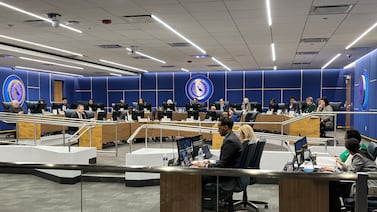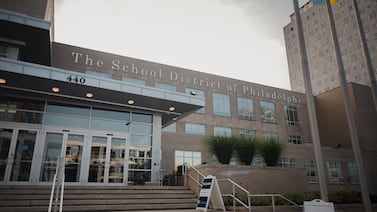Sign up for Chalkbeat Philadelphia’s free newsletter to keep up with the city’s public school system.
Gov. Josh Shapiro proposed a 2024-25 budget Tuesday that increases basic education funding by $1.1 billion, which would be the largest single-year increase ever.
Most of that money, $900 million, would be funneled through a so-called adequacy formula that calculates what every district actually requires to educate all their children to high standards, based on students’ needs.
Shapiro’s proposal comes almost exactly one year after Commonwealth Court Judge Renee Cohn Jubelirer’s ruling that Pennsylvania’s school funding system is unconstitutional – meaning it is neither fair nor adequate and depriving many children of their right to a “thorough and efficient” education. Currently, districts that educate high numbers of students in poverty, English language learners, and others with special needs generally spend less than wealthier districts, even though their students require more in order to be prepared for college and careers.
Shapiro said in his Tuesday address that his spending blueprint “will deliver real results for the Commonwealth” by “making historic investments in public education.”
Shapiro’s proposal also hews closely to the recommendation of the Basic Education Funding Commission, which spent a year traveling the state to question educators, advocates, experts, and others about education in their communities. By “acting on the work” of the commission, the budget is “delivering a comprehensive solution on K-12 education in Pennsylvania,” he said.
In a report released last month, the commission determined that the state should spend $5.4 billion more annually to bring all districts to adequate funding, with $5.1 billion of that coming from state as opposed to local coffers. It set out a plan to reach that goal by 2029.
The remaining $200 million in Shapiro’s proposed $1.1 billion increase would be funneled through the formula established by the funding commission, which also takes into account student needs in devising a per-pupil rate for state aid. This would assure that wealthier districts like Lower Merion and Radnor still get a share of state aid to help with inflation and other cost drivers.
Under the proposal, Philadelphia would receive an increase of $203 million in adequacy funding, plus $40 million additional through the standard formula.
It would also get a share of the $50 million increase Shapiro is proposing for special education funding, and a share of a $300 million increase in facilities funding.
Shapiro also proposes to cap cyber charter tuition at $8,000 per student, which could provide significant savings for Philadelphia public schools. Philadelphia now pays $11,502 per cyber charter student.
The budget does not include vouchers, which are backed strongly by Republicans who control the Senate and share power in an almost equally divided General Assembly. The state already has two programs that offer tax credits to corporations that donate to scholarship programs, but Shapiro does not recommend any funding increases for them.
Last year, Shapiro publicly stated his support for creating vouchers in Pennsylvania. But he ultimately vetoed a provision to establish vouchers when he signed the state budget. On Tuesday, Shapiro reiterated his support for vouchers and said he considered them “unfinished business.”
‘The transformation of Pennsylvania’s school funding system’
Advocates who brought the 2014 lawsuit that ultimately led to Jubelirer’s ruling, William Penn School District et al. v. Pennsylvania Department of Education, hailed the budget proposal, which is just a starting point in negotiations before a final budget is adopted by the end of June. They said it meets the mandate of Jubelirer’s ruling.
“If carried out to completion, this would mean the transformation of Pennsylvania’s school funding system,” said Dan Urevick-Ackelsberg, executive director of the Public Interest Law Center. “It would mean thousands of more teachers, counselors, librarians – it would truly be historic.”
Deborah Gordon-Klehr, director of the Education Law Center, hailed the governor’s proposal as “critical,” adding that “it’s the start of what needs to be a long term commitment.”
She said her group would be seeking legislation to guarantee future increases to reach the target set by the commission “so districts can plan, leaders can be held accountable, and students can see the benefits.”
The adequacy formula devised by the funding commission looks at what the most successful districts spend per student and determines what every district needs to get all their students to that level, using a weighted formula that takes into account poverty, English language status, and other circumstances. Philadelphia’s “adequacy gap” was determined to be in the range of $1.4 billion, on a current budget of about $4.5 billion, or about $7,100 per student.
Philadelphia has the 35th highest adequacy gap in the state; Reading’s shortfall of $14,000 between what it has and what it needs is the widest.
Shapiro’s proposal “targets the funding specifically for the districts that are farthest from adequacy,” said Urevick-Ackelsberg.
Of the 500 districts in Pennsylvania, about 400 do not meet their adequacy targets as defined by the commission.
The governor’s proposal to reform cyber charter funding is likely to run into political headwinds.
Pennsylvania has one of the largest cyber charter enrollments in the country, and districts pay cyber charters their own per-pupil costs, even though cyber education costs far less to deliver than brick-and-mortar schools.
“Currently, cyber charter schools in Pennsylvania charge school districts between $8,639 and $26,564 per student per year,” Shapiro said. This, he said, “no longer makes sense. The 2024-25 budget establishes a statewide cyber tuition rate of $8,000 per student per year and will better align tuition with the actual costs of providing an online education.”
He said this reform will save school districts an estimated $262 million annually.
Other education highlights of Shapiro’s budget include:
- $50 million for school safety and security.
- $300 million in “sustainable funding for environmental repair projects” in school buildings.
- $10 million for teacher recruitment.
- $15 million, an increase of $5 million, for student-teacher stipends.
- $100 million for mental health funding in K-12 schools.
- $3 million to provide free breakfast for all students year-round.
- $96,000 to help free up $62 million in federal child care reimbursements for providers.
Dale Mezzacappa is a senior writer for Chalkbeat Philadelphia, where she covers K-12 schools and early childhood education in Philadelphia. Contact Dale at dmezzacappa@chalkbeat.org.






